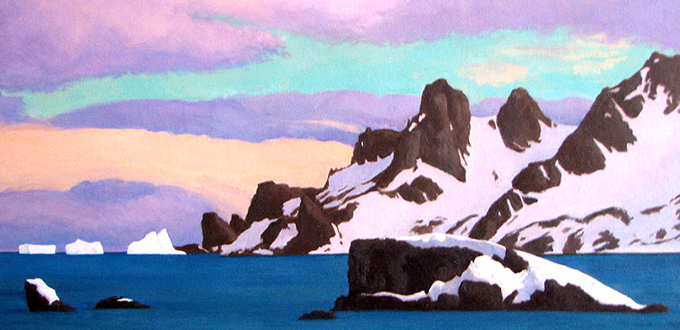
Hiba Schahbaz holds a BFA in Miniature Painting from the National College of Arts, in Lahore, Pakistan and an MFA in painting from the Pratt Institute. She has exhibited extensively in United States and abroad. For more information, visit her website.
Helen Dwork: You studied miniature painting at the National College of Arts in Lahore, the premier institution for the discipline. How does your own work deviate from miniature painting as you were taught?
Hiba Schahbaz: Miniature painting comes from a larger tradition of Indo-Persian art, and was integrated into the contemporary art curriculum at the National College of Arts, Lahore in 1980. As a student, I discovered a deep respect for this tradition and culture. I spent many years honing particular technical skills in miniature painting, which I utilize in my practice today. These include the making of tiny squirrel-haired brushes, the mixing of paints, the preparation of paper, and the use of gold leaf, as well as several traditional painting techniques.
Whereas miniature painting has a history as a decorative art form that documents history, my work in miniature focuses more on self-expression. I strive to create work that has its own voice, instead of producing a beautiful, yet inaccessible object. The narratives I create are rooted in reality but are also heavily embellished by my imagination.
HD: Traditionally, miniature painting was taught through apprenticeships that could last decades, yet your own studies were briefer than this, and your workshops are briefer still. How do you choose which elements of the art form to convey to students?
HS: The workshops I conduct at the Art Students League are a microcosm of a more expansive genre. They focus on one aspect of a particular technique. I structure these workshops to begin with fundamental exercises that are particular to the miniature tradition. I then work with each student to create one finished piece. Along the way, I methodically impart the philosophy behind each aspect of the painting process so that my students are confident in their abilities moving forward.
HD: Miniature paining has a centuries-old heritage of assimilating Western aesthetic principles into Eastern art. In light of this compounded history, do you feel that your own work is subverting the genre or simply continuing it?
HS: Miniature painting is an art form that has been adapting and growing for centuries. This was partly due to the movement of artisans from one area to another. During the fifteenth and sixteenth centuries, the period considered the golden age of miniature painting, artists began to take into consideration the aesthetic preferences of their patrons. Subsequently, the presence of the East India Company was felt in the subcontinent, so Western art again began gaining in popularity in the East.
As an artist, I am a communicator of my time. With this role comes a sense of cultural awareness. Since I come from a different part of the world, however, I also have a responsibility to keep my traditions alive. Instead of a historical narrative, my artwork unfolds a deeply personal narrative influenced by my socio-cultural background. The resulting subversion of the miniature painting genre, if any, is an organic development which comes from being between two worlds.
HD: You’ve noted that you use self-portraiture to “depict socio-cultural narratives.” Is there a distinction between using it for that and using it to contribute to your own self-identification through art, or are the two connected?
HS: I believe that art and life mirror each other. In my case, they are intricately woven together. My artwork reflects many different facets of my life, my emotions, and my surroundings. I use my self-portrait in my work to unfold both internal and external narratives and to pose questions regarding myself and my environment.
Hiba Schahbaz, The Sleepover, 2012.
Hiba Schahbaz, My Selves, 2012.
Hiba Schahbaz, Silent Cry, 2014.
Hiba Schahbaz, Self-Reflection, 2013.
Hiba Schahbaz, American Beauty, 2013.
Hiba Schahbaz, Untitled, 2014.
Hiba Schahbaz, The Bath, 2013.




